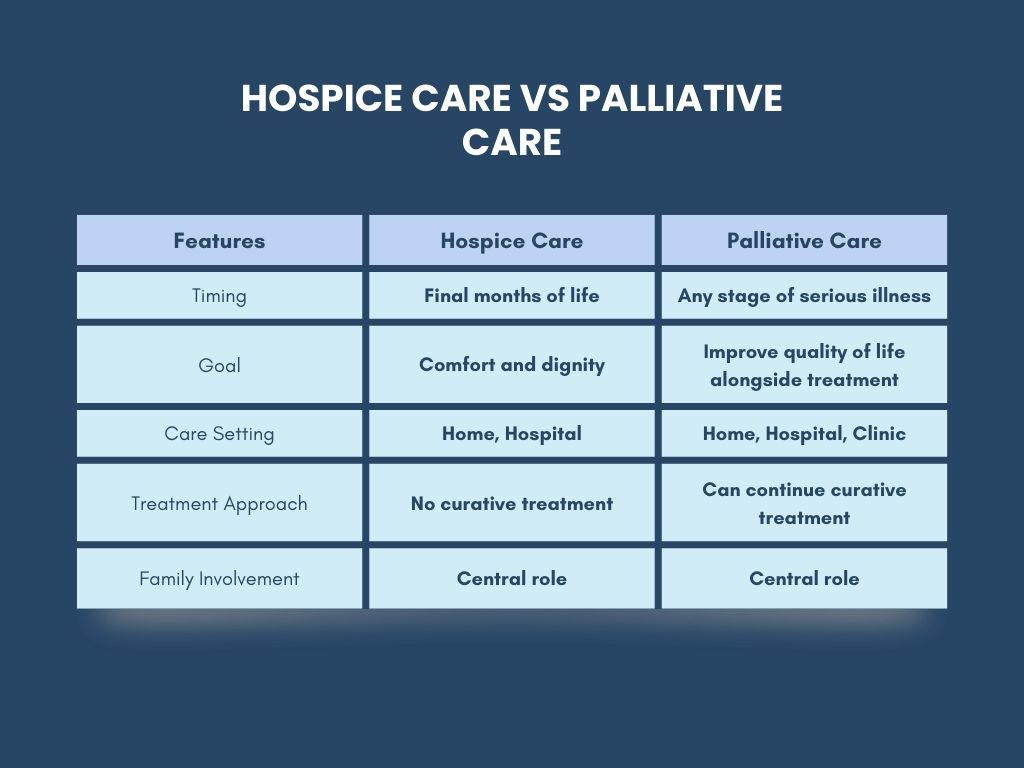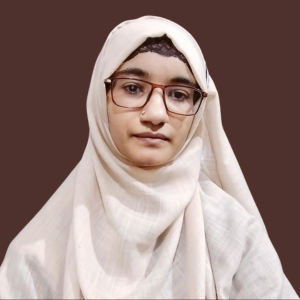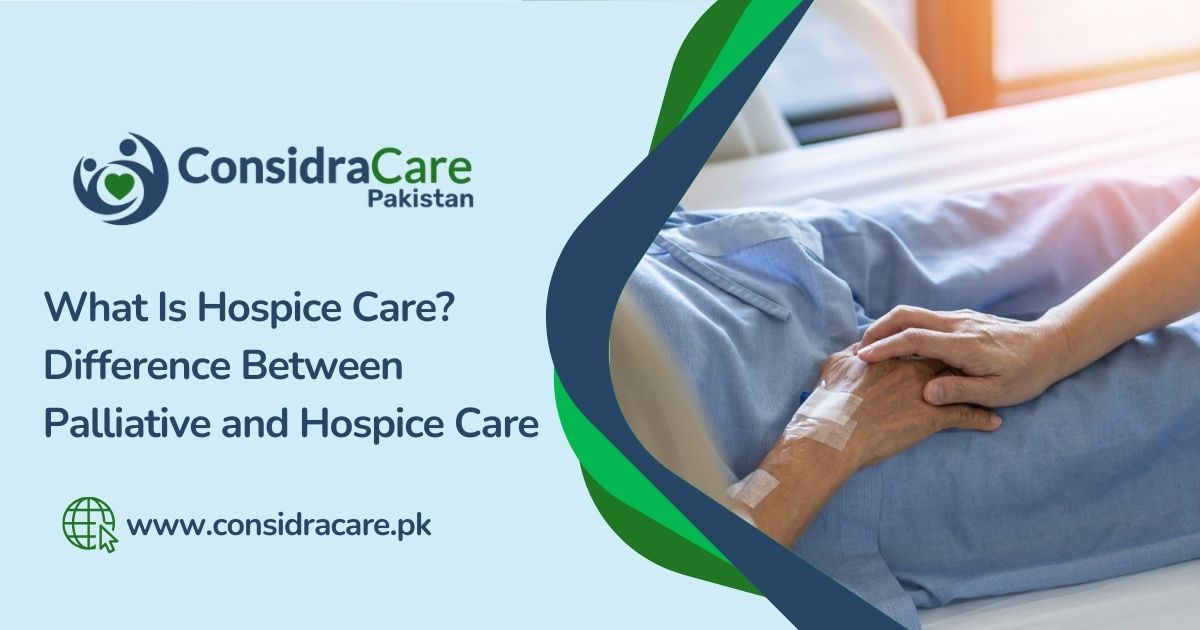Seeing a loved one struggle with a long-lasting or incurable illness is always challenging. In these situations, families often look for ways to ease their loved one’s pain and provide comfort. This is where palliative and hospice care come into play.
While these services do not cure the illness, they focus on improving quality of life, managing symptoms, and offering emotional, spiritual, and practical support.
In this article, we will explore what hospice and palliative care are, how they differ, what families can expect, and why early involvement can make a significant difference.
What Is Hospice Care?
Hospice care is a specialised type of medical support designed for individuals who are nearing the end of life, typically with a prognosis of six months or less. The primary focus is on comfort, dignity, and quality of life rather than attempting to cure the illness.
Read More: A Comprehensive Guide to End of Life Treatment Care in Pakistan
In Pakistan, hospice care is often provided in the patient’s home, allowing them to be surrounded by loved ones in a familiar environment. However, some patients may receive care in hospitals, hospice centres, or smaller local hospice facilities.
A team of professionals, including doctors, nurses, and caregivers, delivers hospice care. Together, they work to ensure that the patient experiences minimal discomfort and emotional distress while also providing support to the family throughout the process.
Main Services of Hospice Care
Hospice care has several distinctive features that set it apart from other forms of medical support:
- Eligibility: Hospice care is typically available for patients with serious illnesses and a life expectancy of about six months or less, as certified by a physician.
- Focus on Comfort: The primary goal of hospice care is pain management and symptom relief. This includes alleviating discomforts such as nausea, shortness of breath, anxiety, and other distressing symptoms.
- Where Hospice Care Is Provided: Many families prefer to receive hospice care at home, although hospitals, nursing homes, and hospice centers are also valid options. In Pakistan, there is often a strong preference for family-centered home care.
- Team-Based Approach: A comprehensive team of professionals is involved in providing care. Volunteers may assist with daily tasks or offer companionship, which is especially important in Pakistan, where family networks are highly valued.
- Support for Families: Hospice care supports not just the patient, but the entire family. Counseling and caregiver training are provided to help families cope with emotional stress and grief.
Goals of Hospice Care
Hospice care focuses on making the final stages of life peaceful and meaningful. The key goals include:
- Relieving Pain and Discomfort: Ensuring that patients feel as comfortable as possible every day.
- Managing Physical Symptoms: Addressing common issues such as fatigue, nausea, shortness of breath, and loss of appetite.
- Supporting Families in Coping: Families receive training to assist with care while also getting emotional support.
- Respecting Patients’ Wishes and Dignity: Care is personalized to honor the values and choices of the patient.
Benefits of Hospice Care
- Comfort First: Hospice care prioritizes managing pain and alleviating symptoms to ensure patients feel as comfortable as possible.
- Personalized Care: Each care plan is tailored to meet the individual physical, emotional, and spiritual needs of the patient.
- Dignity and Respect: Patients are supported in living their final days with honor, respect, and compassion.
- Family Support: Families receive counseling, respite breaks, and guidance, so they do not have to navigate the journey alone.
- Care at Home: Many services are provided at home, allowing patients to remain in a familiar and peaceful environment.
- Team Approach: A dedicated team of doctors, nurses, social workers, and volunteers collaborates to provide comprehensive care.
- Better Quality of Life: By minimizing stress and discomfort, hospice care helps patients make the most of the time they have left.
What Is Palliative Care?
Palliative care is designed for people with serious illnesses at any stage, not just for those near the end of life, unlike hospice care. Its primary focus is on improving quality of life, managing symptoms, and supporting patients’ mental, emotional, and spiritual well-being.
Palliative care can be provided alongside curative treatments such as chemotherapy, dialysis, or surgery. Patients do not have to stop their regular treatments to receive palliative support.
In Pakistan, palliative care is increasingly available at home, in hospitals, and at specialized clinics, ensuring that families can access professional support while respecting cultural norms surrounding family involvement.
Read More: What is Palliative Care and How it Helps Seniors?
Main Services of Palliative Care
- Eligibility: Palliative care is beneficial for any patient with a serious illness, including cancer, heart disease, kidney failure, chronic obstructive pulmonary disease (COPD), or neurological disorders.
- Focus on Quality of Life: The priorities of palliative care include effective symptom management, emotional support, and holistic care.
- Where Palliative Care Is Provided: Palliative care can be accessed in various settings, such as hospitals, outpatient clinics, nursing homes, long-term care facilities, or through home-based services.
- Team-Based Care: A team of healthcare professionals, including doctors, nurses, social workers, and counselors, collaborates to provide comprehensive care.
- Support for Families: Families receive education, emotional support, and guidance for caregivers to help reduce stress and enhance the quality of care.
Benefits of Palliative Care
- Effective Symptom Management: Palliative care professionals provide support in managing pain, nausea, shortness of breath, and fatigue, allowing patients to experience greater comfort.
- Enhanced Quality of Life: Many patients report improvements in overall well-being, including better sleep, emotional stability, and stronger communication with family members.
- Reduced Risk of Depression: Early palliative interventions help patients address mental health challenges during illness, which can significantly reduce stress and anxiety.
- Guidance in Decision-Making: Families receive professional advice for medical decisions, ensuring that care aligns with the patient’s preferences and wishes.
- Support for Families: Caregivers benefit from emotional support, practical training, and access to respite care.
- Cost-Effective Care Options: Home-based palliative care can lower hospital costs and allows patients to stay in a familiar environment, which is particularly valued in Pakistan.
Difference Between Palliative and Hospice Care

Common Myths About Hospice and Palliative Care
- Myth: Hospice means giving up hope.
Fact: Hospice focuses on dignity and comfort, rather than abandoning hope.
- Myth: Palliative care is only for the end of life.
Fact: Palliative care can begin at any stage of a serious illness.
- Myth: These services shorten life.
Fact: Effective symptom management often improves overall well-being and may even extend life.
- Myth: Hospice care can only be provided in facilities.
Fact: Home-based hospice care is widely available and practiced, especially in Pakistan.
- Myth: Families have no role in the process.
Fact: Families play a central role, providing care while also receiving guidance and emotional support.
Choosing the Right Care: Practical Advice for Families
- Consider early involvement: Introducing palliative care at an early stage can help prevent unnecessary suffering.
- Discuss care preferences openly: Have conversations with your loved one about their comfort, spiritual support, and treatment options.
- Evaluate local options: Hospitals like Shifa International and St. Joseph’s Hospice offer structured programs, but there are also local home-based services available.
- Integrate family support: In Pakistan, multi-generational households often make home-based care more suitable. Families can directly participate in care while receiving guidance from trained professionals.
Decide Between Hospice and Palliative Care
- Select palliative care if your loved one is still receiving curative treatments but needs assistance with symptom management.
- Choose hospice care when treatments are no longer effective, or when the side effects outweigh the benefits, as this approach focuses on comfort and quality of life in the final months.
Real-Life Examples
- Example 1:
A senior with advanced heart disease was facing frequent hospital visits and experiencing fatigue. The family arranged for palliative care at home, which helped manage symptoms, provided counseling, and educated them on daily care. This arrangement allowed the family to enjoy a more peaceful, stress-free time together.
- Example 2:
An elderly patient with late-stage cancer was receiving care at home from a hospice team. The professionals managed pain, monitored symptoms, and provided emotional and spiritual support. The family was guided on how to care for their loved one while also coping with their grief. This enabled them to spend meaningful, tranquil moments together during the patient’s final months.
These approaches reflect the Pakistani cultural emphasis on family-centered care, allowing loved ones to remain at home, surrounded by familiar faces and traditions while receiving professional medical support.
Join Considra Care for Compassionate Support
At Considra Care, we offer professional home-based palliative and hospice care tailored to meet your loved one’s needs. Our experienced teams provide personalized support, manage symptoms, and enhance quality of life, while also guiding families through each step of the care journey.
Contact us today to discover how Considra Care can bring comfort, dignity, and peace to your family during these challenging times.
Conclusion:
Caring for a senior with a serious illness can be challenging. Hospice and palliative care offer options that address physical, emotional, and spiritual needs while empowering families to participate in the care process.
By understanding these services, individuals can make informed choices that respect cultural values, reduce stress, and ensure dignity for their loved ones.
Frequently Asked Questions
1. What is another name for hospice care?
Hospice care is sometimes referred to as end-of-life care or comfort care, as it focuses on providing comfort, dignity, and quality of life rather than attempting to cure the illness.
2. What services are typically provided in hospice care?
Hospice care offers medical, emotional, and spiritual support to ensure comfort and dignity at the end of life.
3. What happens during the first stage of hospice care?
The first stage involves an eligibility assessment and admission, where a doctor certifies the patient’s condition, and a personalized care plan is created.
4. What are the four main pillars of palliative care?
The four pillars of palliative care are physical, emotional, social, and spiritual support for patients and their families.
5. How does hospice care differ from palliative care?
Hospice care is designed for patients who are nearing the end of life, while palliative care can be provided at any stage of a serious illness, alongside treatments aimed at improving quality of life.




